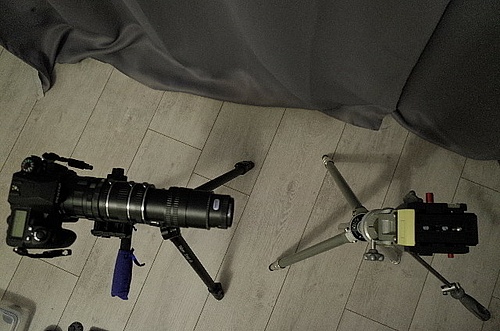I would like to share a slightly different Macro technique than what seems to be the norm of common types of Macro.
I have found with a full set of "Step Up & Step Down Rings" ranging from 37mm to 67mm, and a "M32x0.05 female to M42x1 male" adapter ring, I can place my "Schneider-Kreuznach Comparon 105mm 1:4.5 enlarger lens" on to
any lens I own with a front filter thread between or within that 37 to 67mm range.
This has allowed me to be able to take ultra macro shots better than 5:1 magnification both hand held (with some limited degree of success because of the tiny depth of field) and also in a home studio with a tripod and lighting. Using this setup with a 2x converter & a 100-300mm sigma lens (extended to 300), I have achieved somewhere between 5.731x or 5.875x magnification without a microscope or an actual macro lens and at a much cheaper cost than buying a specialized 5x macro lens. I am unsure about the exact magnification as I think it is between 4 and 4.1 mm on the ruler when the picture is taken (see below)
For the 5.73x or 5.875x magnification, I have used the following setup from front to back :-
Schneider-Kreuznach Comparon 105mm 1:4.5 enlarger lens.
M32x0.05 female to M42x1 male adapter ring.
M42 to M52 Step down ring.
55mm to 52mm Step down ring.
58mm to 55mm Step down ring.
55mm to 58mm Step up ring.
Sigma Zoom 100-300mm f4.5-5.6 for Pentax.
2x converter for Pentax K-mount.
Pentax K-70.
I have tried reversing the enlarger lens on front of other lenses but I get little or no difference in magnification without being reversed.
I tend to get better image quality when not reversing the enlarger lens. I am guessing this is because the enlarger lens is designed to be a flat lens with zero distortion or curvature.
I have also used a JJC intervalometer (Timer remote series) plugged into the K-70, & a sliding macro rail on a tripod so as to avoid camera shake as the depth of field is extremely tiny. For extra lighting I used a "Godox LED M150" solid light and another LED light from a soldering station (which was holding the ruler) and was measured to be 89mm from the front of the enlarger lens and 352mm from the sensor center line (marked on top of the k-70).
I am quite happy with the Schneider lens helping to make an cheap and ordinary zoom into a mighty macro tool at almost 6x magnification.
I aim to post some interesting macro pics in the nearby future once I find suitable targets (I am open to suggestion).
I hope this also helps others aiming for similar results or those on a budget wishing to get into macro relatively cheaply.
The ruler used for the photos is showing millimeters
This is a pic of the setup used :-  Extreme Macro (5.731x) with enlarger reversed (1 second shutter speed) :-
Extreme Macro (5.731x) with enlarger reversed (1 second shutter speed) :-  Extreme Macro (5.875x) with enlarger non reversed (1.5 second shutter speed) :-
Extreme Macro (5.875x) with enlarger non reversed (1.5 second shutter speed) :- 
I am happy to answer any questions that people may have also and will respond as soon as practicable for me.
---------- Post added 12-17-19 at 11:22 PM ----------
Quick Update
I just placed a set of 3 extension tubes (1,2 & 3) between the 2x converter and the Sigma 100-300mm lens for an even better result.
Pentak K-70 sensor width = 23.5mm
Picture shown = 2.3mm
Magnification = 10.21x
I am now just amazed at this new result.
From Extreme Macro to micro-photography without a microscope is just awesome.

Last edited by VILLAINofOZ; 12-17-2019 at 04:45 AM.
Reason: missed info


 Similar Threads
Similar Threads 

















 Post #5 by tryphon4
Post #5 by tryphon4








